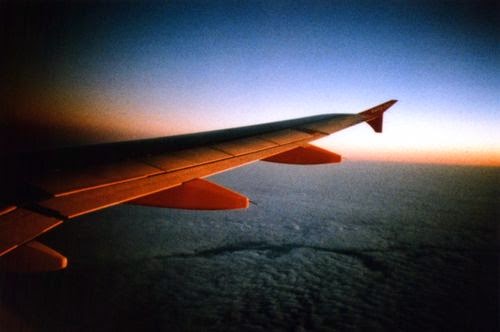WWPD 2013: Chewing Gum Box 35mm Pinhole Camera Tutorial
Today, while I was drinking my umpteenth soda of the day, I felt like a chewing gum. With the shewing gum box in one hand and a can in the other, I had the epiphany: tiny box + aluminum = pinhole camera!
To make this revelation turn into a pinhole camera I used the afore-mentioned chewing gum box and can, black insulating tape, normal tape, a pencil, a marker, a pin, scissors and two rolls of 35mm film [an empty one and a "fresh" one].
First, I decided where my film would pass through the box. I marked two parallel lines on the front [representing very approximately the film]...
...And one per side, as tall as the film cartridge.
Back to the front, I marked [again, with my distinctive scientific precision] the centre of the "film path".
I cut a small rectangular window there...
...And taped a little piece of tin foil [cut out from the soda can] that I had pierced right in its centre with the tip of a pin.
I then cut along the two lateral lines to make the slits through which film would get through the "camera". I used a pen to crack the slits a little more in order to make it easier to insert the cartridge's edge.
I mentioned you need two rolls of film. Actually, you only need one, the other one can be an empty cartridge, as the one I used.
It is so wrecked because lately I've started developing film at home but have yet to master how to pull film out of the cartridge. Anyway, it doesn't really matter if your empty cartridge looks as bad as mine as long as you can still turn the spool, as you will have to tape about every inch of it soon.
Now it was time to put the film in my soon-to-be pinhole camera. Here I was faced with two options:
1. Shooting the film the good old way and get normal pictures
2. Shooting the film the other way and get redscale pictures.
As it's been a while since the last time I shot some redscale film, I decided to go for the redscale.
I inserted the film slotting the cartridge in into the chewing gum box and made the film go all the way through the other slit.
I used black tape to hold everything still and to prevent light from leaking in.
I then taped the fresh film to the last bit still coming out from the old cartridge's spool.
I wound a bit to make sure the film inside was well stretched.
Next I covered the old cartridge and most of the box as well, except for the top of the cartridges [so that I could still advance/rewind the film] and the pinhole.
I made my shutter folding on itself a piece of tape as long as the chewing gum box, leaving a sticky part on top.
I glued the sticky part to the top of my camera, adding another piece of tape [the red one] on the bottom to keep the shutter closed. To open it and take a picture, all I have to do is lifting the long black tape.
I added some more red tape on the top to keep the shutter closed better... and some more on the sides just because.
To advance the film, I put a paper clip in the top of the old roll's cartridge, making two full turns to advance to the next frame. I've read somewhere that one turn and a half is enough, but I personally prefer to make two whole turns.
Also, I keep by my side this helpful exposure guide which comes with the Diana Multi Pinhole Operator to help me determine exposure times:
I will share my results (or whine about my epic failure) as soon as I get the roll developed.
With World Pinhole Photography Day just a few days ahead, fancy building a pinhole camera yourself?
Here's another tutorial to make a 35mm pinhole camera out of an empty film box, while here's a tutorial to build a DIY Instant Pinhole Camera and finally one more tutorial to make a 110 pinhole camera.
Have fun and feel free to share your own pinhole projects!
.png)





























carinaaaaaa!
ReplyDeleteGrazie!!
ReplyDeleteThank you for every other informative web site. The place else could I
ReplyDeleteget that type of info written in such an ideal method? I've a mission that I am simply now operating on, and I have been on the look
out for such info.
my blog :: stairlifts